#A ROMAN MARBLE SARCOPHAGUS PANEL
Explore tagged Tumblr posts
Text
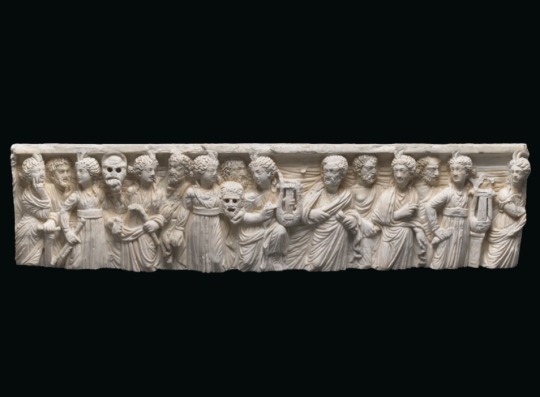

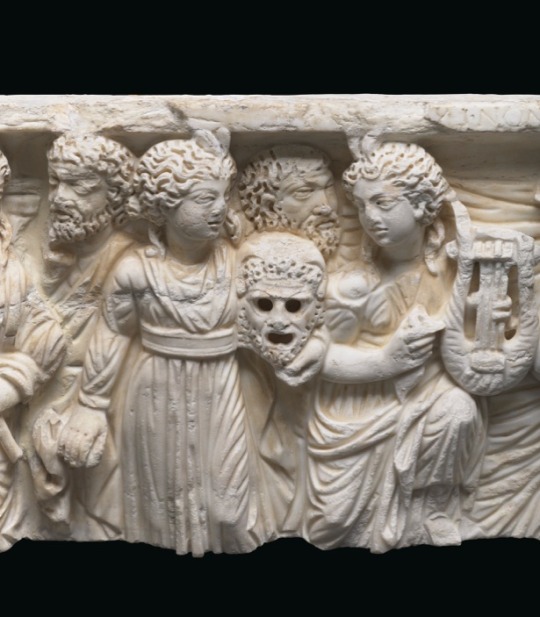
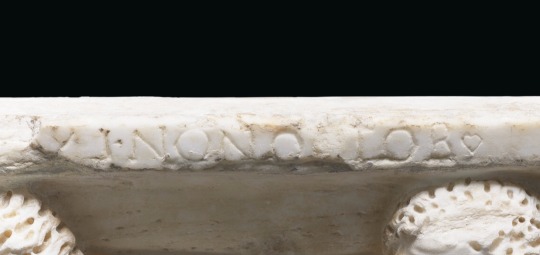

A ROMAN MARBLE SARCOPHAGUS PANEL CIRCA 3RD CENTURY A.D.
The panel is inscribed in Latin over the top border with 'DEFV[NCT(VS)] VI NON(AS) OCTOB(RES)♡' which reads 'died the sixth day before the Nones of October', which corresponds to the 2nd October. It is very unusual for the date of death to be recorded without any further details of the deceased in a Roman epitaph of this date, as this becomes customary only from the 4th Century onwards, particularly on Early Christian sarcophagi. The quality of the lettering appears to be of lesser quality if compared to the workmanship of the carving and might possibly indicate a later re-use of the sarcophagus.
#A ROMAN MARBLE SARCOPHAGUS PANEL#CIRCA 3RD CENTURY A.D.#marble#marble statue#marble sculpture#ancient artifacts#archeology#archeolgst#history#history news#ancient history#ancient culture#ancient civilizations#ancient rome#roman history#roman empire#roman art#ancient art
23 notes
·
View notes
Text
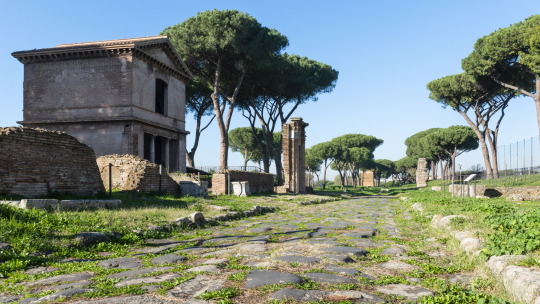
Antigua Via Latina / The ancient Via Latina
In the middle of the Roman periphery, between the modern Via Appia and Via Tuscolana, a section of the 3rd mile of the ancient Via Latina is preserved in perfect condition.
It has ancient origins: the natural route, already followed in prehistoric times, was used by the Etruscans to colonise Campania in the 8th-6th centuries BC.
Definitely laid out by the Romans around the IV-III centuries B.C., it connected Rome with Capua, maintaining its importance throughout Antiquity. In fact, even in the Middle Ages, it was preferred as an access road to Naples because of its better preservation compared to the Appian Way and the presence of a number of Christian places of worship along the route..
Entering the Archaeological Park of the Tombs of the Via Latina, it is now possible to walk along a section of the original paving of the street. With a pleasant walk you can admire the rich tombs dating back to the I-II century A.D. that overlooked the route, which still have perfectly preserved polychrome decorations on the façades and inside: vaults covered with painted plaster and stucco, walls frescoed with funerary scenes and rich mosaic floors are still substantially intact in their original context.
From the street it is also possible to reach the Basilica of S. Stefano, a rare example of an early Christian building erected under the pontificate of Leo the Great in the middle of the 5th century.
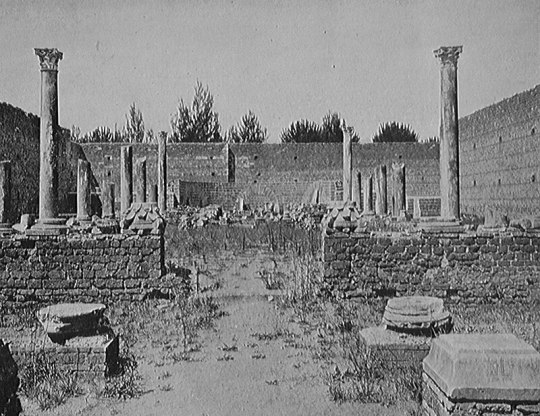
Santo Stefano en Vía Latina, restos parcialmente reconstruidos, 1911.
Santo Stefano in Via Latina, partially reconstructed remains, 1911.
The Archaeological Park of the Tombs of the Via Latina was created in 1879 following the acquisition by the State of a vast area in which important remains from Roman times had been discovered.
BARBERINI TOMB
The so-called Barberini Sepulchre, or Sepulchre of the Corneli. The funerary monument, dating from the 2nd century AD, consists of two above-ground floors and a hypogeum in an excellent state of preservation. The upper floor is covered by a ribbed vault completely covered with plaster painted with a red background and stucco elements. Groups of figures, winged victories on chariots, love affairs, birds, marine animals, mythological themes and architectural backgrounds can be recognised.

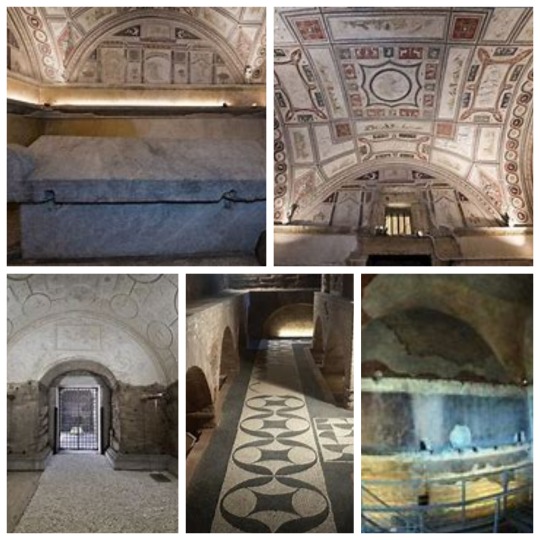
Sepulcro Barberini y su interior / Barberini Tomb and its interior
TOMB OF THE VALERI
The Tomb of the Valeri. The richly decorated underground rooms dating from the mid-2nd century AD are preserved, while the elevation is a hypothetical reconstruction dating from the mid-19th century. An elaborate white stucco covering, articulated in 35 medallions and panels, adorns the lunettes and the barrel vault of the underground room. The medallions depict Dionysian themes, female figures and sea animals, while in the central tondo there is a delicate-veiled figure on the back of a griffin, representing the deceased being carried to the afterlife.
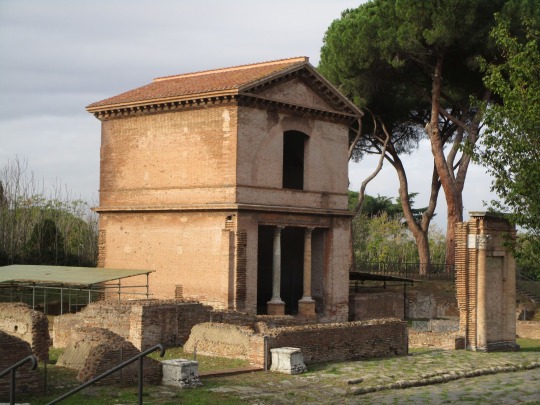
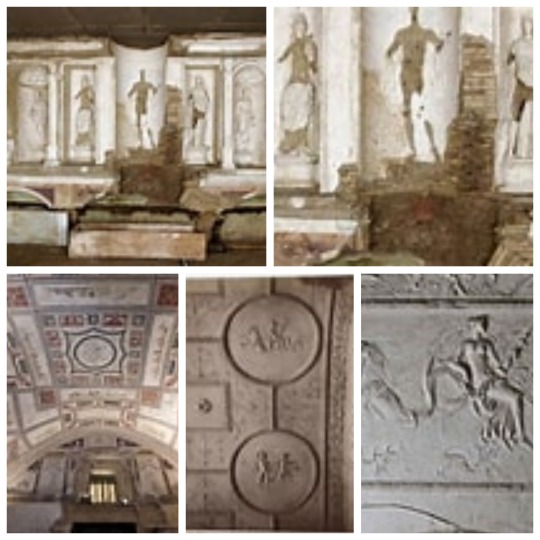
Tumba de los Valeri, exterior e interior / Tomb of the Valeri, exterior and interior
THE TOMB OF THE PANCRATII
The Tomb of the Pancratii. Much of the visible structure is a modern construction that protects the monument below by resting on the original 1st-2nd century AD walls, about a metre high. Upon entering the tomb, one can admire the beautifully decorated underground rooms, with mosaics on the floors and vaults and walls frescoed in bright colours and stucco in an excellent state of preservation. They depict mythological scenes, natural and architectural landscapes, images of women and animals. In the centre of one of the underground chambers is a large sarcophagus for two Greek marble depositions.
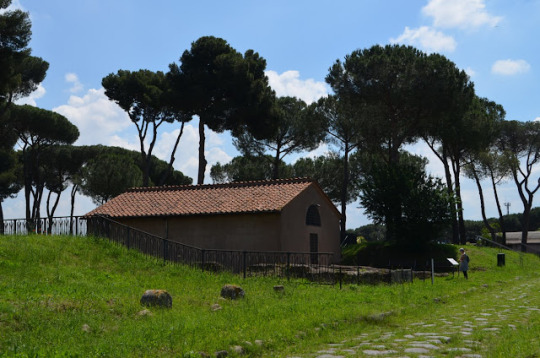

Sepulcro de los Pancracios, exterior e interior / Tomb of the Pancracios, exterior and interior
82 notes
·
View notes
Text


Marble strigilated sarcophagus. Roman ca. 220 CE. x
The sarcophagus was furnished with a lid and placed in a monumental tomb, probably in a niche or on a ledge, with its plain back against the wall. The ferocious-looking lions' heads stand out powerfully against the restrained, almost soothing effect of the strigilated panels on the front. Thisdistinctive type of decoration is restricted largely to sarcophagi made in Rome. The marble is Proconnesian, imported from northwestern Asia Minor.
70 notes
·
View notes
Text

Roman sarcophagus, Carrara marble, used for the burial of the Palermo Archbishop Ugone in 1150. The front panel features two flying genii (protective spirits) supporting a circle with the bust of a man, probably a senator. Under the genii are the god Tiber holding a fish and a branch, and on the other side, the goddess Ceres holding a cornucopia full of fruit. Between them are two theatrical masks. The female figure at the far left may be the goddess Diana, and the male figure on the right may be Apollo with an eagle at his feet.
Photo by Charles Reeza in the crypt of Palermo Cathedral, Sicily
10 notes
·
View notes
Photo
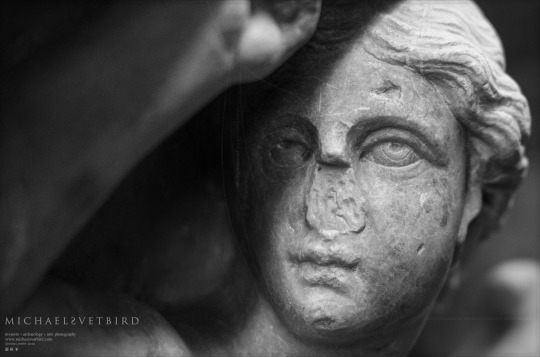

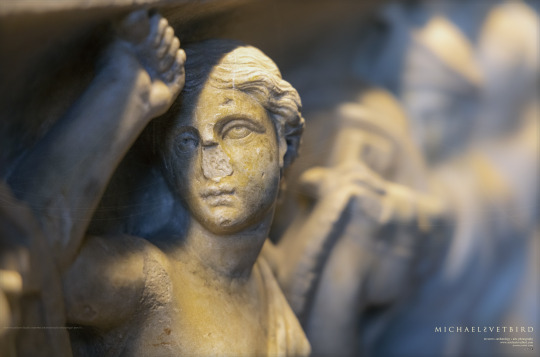


• AMAZONOMACHY Frieze: Front or Side Panel of Roman Sarcophagus, Pentelic Marble, Mid-2nd c. AD, "Mid Antonine Age".
'The Troy Room' of Corte Nuova, Palazzo Ducale, Mantova | Mantua https://mantovaducale.beniculturali.it/en - FB : https://www.facebook.com/DucaleMantova - IG : @palazzoducalemantova - TW : @PalazzoDucaleMN
PDM | Michael Svetbird phs©msp | 07|05|23 6200X4100 600 [I.-IV.] The photographed object is the collection item of PDM | Comune di Mantova and subject to copyrights. [non commercial use | sorry for the watermarks]
📸 Part of the "SARCOPHAGI:Reliefs" MSP Online Photo-gallery:
👉 D-ART: https://www.deviantart.com/svetbird1234/gallery/69396046/sarcophagi-reliefs
👉 FB | Album: https://www.facebook.com/media/set/?set=a.843393602695885&type=3
.
#mantova#mantua#palazzoducalemantova#historymuseum#romanart#ancientart#relief#sculpture#romansculpture#romanempire#sarcophagus#sarcophagi#archaeology#mythology#ancient#amazonomachy#αμαζονομαχία#amazzonomachia#amazons#αμαζόνες#amazzoni#penthesilea#warrioress#oiorpata#antiquity#photogallery#sculpturephotography#archaeologyphotography#museumphotography#michaelsvetbird
18 notes
·
View notes
Photo

Marble statue of Ephebus
Staircase {down) on the Wall.—Large bas-relief of a Thracian horseman from Salonica, 3rd cent. B.c.
BOOM HO. 20.—Marble statues and friezes of Boman period from Aphrodisias.
BOOM NO. 21.—On entering: A marble statue of Ephebus standing, from Tralles. This is one of the finest marble statues of the Museum, and it belongs to the Hellenistic art, i.e., about the 3rd cent. B.c. On the right: Archaic statues. On the left: Statues of the Hellenistic period. Head of Alexander the Great from Cos. Head of Alexander the Great (part of the nose broken) from Pergamos. Bust of Apollo from Tralles, 3rd cent. B.c. This statue was not cut out of a single block, but consisted originally of six pieces held together by clamps.
BOOM NO. 22.—On the right: Statues of the Greco-Roman period. On the left of the Roman period: Statue of Hadrian from Crete, and representing the Emperor standing and trampling on the figure of a child representing Cyrenaica Yicta. Statue of Nero from Tralles.
ROOM NO. 23,OR BYZANTINE HALL.—(On the floor) large mosaic from Syria discovered by Prof. H. Butler of Princeton University. Also several other marble objects of the early Christian period.
ROOM NO. 24.—Marble statues of Roman period.
ROOM NO. 25.—Assyrian statues.
Archaic statue of Hercules
ROOM NO. 26, OR HERCULES ROOM.—Archaic statue of Hercules from Cyprus represented as killing a Ron. Also Assyrian statues.
ROOM NO. 27.—Various funereal steles, mostly from tombs in Asia Minor.
ROOM NO. 1
The sarcophagus called the Satrap’s, No. 18, was unearthed at Saida in 1887 by Hamdi Bey and his party. It is of Paros marble, and was originally painted; traces of blue are still visible on one of its faces, the rest of the colouring having been effaced, and the carvings themselves much worn, by the action of the water which filled the chamber of the catacomb in which it was discovered. One of the comers of the trough and lid was unfortunately broken off during the excavating operations, but the fragments have now been pieced together again.
This sarcophagus, in its general aspect, represents a Greek temple. The trough is in the form of a truncated pyramid, and is anthropoid inside; the bottom is adorned with a row of rais de cceur, and the top with a row of pearls and ovulae; on the sides are four sculptured panels in a framing of carved palm-leaves.
The head or northern panel, represents a funeral banquet. The corpse is depicted laid out on a bier, and is evidently that of some Oriental potentate or satrap, with a long beard and hair bound with a head-band, and clad in long flowing robes. Its left hand grasps a goblet, while its right holds a rhyton, and is extended towards a female figure in a long tunic and with hair confined by a head- band, who stands in front of him in the act of replenishing the rhyton from an oenochoe. Behind the woman is another seated on a chair, and with part of her himcdion drawn over her head, while yet another female figure is depicted towards the satrap’s right.
0 notes
Photo

Marble statue of Ephebus
Staircase {down) on the Wall.—Large bas-relief of a Thracian horseman from Salonica, 3rd cent. B.c.
BOOM HO. 20.—Marble statues and friezes of Boman period from Aphrodisias.
BOOM NO. 21.—On entering: A marble statue of Ephebus standing, from Tralles. This is one of the finest marble statues of the Museum, and it belongs to the Hellenistic art, i.e., about the 3rd cent. B.c. On the right: Archaic statues. On the left: Statues of the Hellenistic period. Head of Alexander the Great from Cos. Head of Alexander the Great (part of the nose broken) from Pergamos. Bust of Apollo from Tralles, 3rd cent. B.c. This statue was not cut out of a single block, but consisted originally of six pieces held together by clamps.
BOOM NO. 22.—On the right: Statues of the Greco-Roman period. On the left of the Roman period: Statue of Hadrian from Crete, and representing the Emperor standing and trampling on the figure of a child representing Cyrenaica Yicta. Statue of Nero from Tralles.
ROOM NO. 23,OR BYZANTINE HALL.—(On the floor) large mosaic from Syria discovered by Prof. H. Butler of Princeton University. Also several other marble objects of the early Christian period.
ROOM NO. 24.—Marble statues of Roman period.
ROOM NO. 25.—Assyrian statues.
Archaic statue of Hercules
ROOM NO. 26, OR HERCULES ROOM.—Archaic statue of Hercules from Cyprus represented as killing a Ron. Also Assyrian statues.
ROOM NO. 27.—Various funereal steles, mostly from tombs in Asia Minor.
ROOM NO. 1
The sarcophagus called the Satrap’s, No. 18, was unearthed at Saida in 1887 by Hamdi Bey and his party. It is of Paros marble, and was originally painted; traces of blue are still visible on one of its faces, the rest of the colouring having been effaced, and the carvings themselves much worn, by the action of the water which filled the chamber of the catacomb in which it was discovered. One of the comers of the trough and lid was unfortunately broken off during the excavating operations, but the fragments have now been pieced together again.
This sarcophagus, in its general aspect, represents a Greek temple. The trough is in the form of a truncated pyramid, and is anthropoid inside; the bottom is adorned with a row of rais de cceur, and the top with a row of pearls and ovulae; on the sides are four sculptured panels in a framing of carved palm-leaves.
The head or northern panel, represents a funeral banquet. The corpse is depicted laid out on a bier, and is evidently that of some Oriental potentate or satrap, with a long beard and hair bound with a head-band, and clad in long flowing robes. Its left hand grasps a goblet, while its right holds a rhyton, and is extended towards a female figure in a long tunic and with hair confined by a head- band, who stands in front of him in the act of replenishing the rhyton from an oenochoe. Behind the woman is another seated on a chair, and with part of her himcdion drawn over her head, while yet another female figure is depicted towards the satrap’s right.
0 notes
Photo

Salonica in 1887
Sarcophagus No. 88.—This sarcophagus was discovered at Salonica in 1887. It is of white marble, and its trough is rectangular. At two of its corners are two nude cupids, standing on one leg with arms extended and holding up a drapery spread behind them; in the background are two eagles.
The central figures on one of the sides are those of Cupid and Psyche standing arm-in-arm by a kindled altar; on the other side of them are cupids nude but for a chlamys over their shoulders. In each of the two groups of cupids, one is represented leaning on the other for support. The one on the left is laying a wreath on the altar, and the one on the right holds a butterfly. The carvings on the opposite side of the sarcophagus represent two lions’ heads encircled in a garland supported by a nude cupid. At the head of the sarcophagus is the figure of a winged sphinx; and at the foot that of a nude cupid holding a lowered torch in one hand and a wreath in the other. This sarcophagus belongs to the Roman art period also.
Sarcophagus No. JO.—This sarcophagus comes from Tripoli in Barbary, and was discovered in November 1885. It is of yellow marble and has never been completed, one of its panels only having been carved, while the others remain uncut and are quite plain, save for the sketched design made for the sculptor. At each end of the carved panel is a tree, that on the left having the figure of a dog sitting under it. In the centre is the figure of Hippolytus, nude, except for a chlamys hanging down from his left shoulder and appearing as if .about to fall off altogether. In his left hand is a javelin, and at his baldric hangs a hunting-knife. In front of him is his horse ready bridled and pawing the ground, and beyond are two nude hunters.
He is being accosted by Phaedra’s nurse, who has given him some tablets which he is holding. Behind the nurse, and apparently listening to all she says, is a standing female figure leaning its chin on its hand. At the extreme left is Phaedra, seated in an arm-chair, veiled and wearing a wreath, and in the attitude of listening to a woman behind her who is stooping down to whisper to her; at Phaedra’s feet stands a cupid with his hands on her knees, looking up into her face.
Eoom No. 1 contains a Greek-Roman sarcophagus covered with representations of Bacchanalian scenes, besides various funereal bas-reliefs, and a fine collection of Phoenician cast-lead sarcophagi, covered with bas-reliefs. These monuments seem to have been peculiar to Phoenicia, inasmuch as they have all come from the Lebanon and Homs districts in Northern Syria, and apparently date from the very beginning of the Christian era, or from the end of the first century B.c. The ornamentations on them are chaste and varied in design, and indicate an admixture of Phoenician and Greek-Roman style.
0 notes
Photo

Salonica in 1887
Sarcophagus No. 88.—This sarcophagus was discovered at Salonica in 1887. It is of white marble, and its trough is rectangular. At two of its corners are two nude cupids, standing on one leg with arms extended and holding up a drapery spread behind them; in the background are two eagles.
The central figures on one of the sides are those of Cupid and Psyche standing arm-in-arm by a kindled altar; on the other side of them are cupids nude but for a chlamys over their shoulders. In each of the two groups of cupids, one is represented leaning on the other for support. The one on the left is laying a wreath on the altar, and the one on the right holds a butterfly. The carvings on the opposite side of the sarcophagus represent two lions’ heads encircled in a garland supported by a nude cupid. At the head of the sarcophagus is the figure of a winged sphinx; and at the foot that of a nude cupid holding a lowered torch in one hand and a wreath in the other. This sarcophagus belongs to the Roman art period also.
Sarcophagus No. JO.—This sarcophagus comes from Tripoli in Barbary, and was discovered in November 1885. It is of yellow marble and has never been completed, one of its panels only having been carved, while the others remain uncut and are quite plain, save for the sketched design made for the sculptor. At each end of the carved panel is a tree, that on the left having the figure of a dog sitting under it. In the centre is the figure of Hippolytus, nude, except for a chlamys hanging down from his left shoulder and appearing as if .about to fall off altogether. In his left hand is a javelin, and at his baldric hangs a hunting-knife. In front of him is his horse ready bridled and pawing the ground, and beyond are two nude hunters.
He is being accosted by Phaedra’s nurse, who has given him some tablets which he is holding. Behind the nurse, and apparently listening to all she says, is a standing female figure leaning its chin on its hand. At the extreme left is Phaedra, seated in an arm-chair, veiled and wearing a wreath, and in the attitude of listening to a woman behind her who is stooping down to whisper to her; at Phaedra’s feet stands a cupid with his hands on her knees, looking up into her face.
Eoom No. 1 contains a Greek-Roman sarcophagus covered with representations of Bacchanalian scenes, besides various funereal bas-reliefs, and a fine collection of Phoenician cast-lead sarcophagi, covered with bas-reliefs. These monuments seem to have been peculiar to Phoenicia, inasmuch as they have all come from the Lebanon and Homs districts in Northern Syria, and apparently date from the very beginning of the Christian era, or from the end of the first century B.c. The ornamentations on them are chaste and varied in design, and indicate an admixture of Phoenician and Greek-Roman style.
0 notes
Photo

Salonica in 1887
Sarcophagus No. 88.—This sarcophagus was discovered at Salonica in 1887. It is of white marble, and its trough is rectangular. At two of its corners are two nude cupids, standing on one leg with arms extended and holding up a drapery spread behind them; in the background are two eagles.
The central figures on one of the sides are those of Cupid and Psyche standing arm-in-arm by a kindled altar; on the other side of them are cupids nude but for a chlamys over their shoulders. In each of the two groups of cupids, one is represented leaning on the other for support. The one on the left is laying a wreath on the altar, and the one on the right holds a butterfly. The carvings on the opposite side of the sarcophagus represent two lions’ heads encircled in a garland supported by a nude cupid. At the head of the sarcophagus is the figure of a winged sphinx; and at the foot that of a nude cupid holding a lowered torch in one hand and a wreath in the other. This sarcophagus belongs to the Roman art period also.
Sarcophagus No. JO.—This sarcophagus comes from Tripoli in Barbary, and was discovered in November 1885. It is of yellow marble and has never been completed, one of its panels only having been carved, while the others remain uncut and are quite plain, save for the sketched design made for the sculptor. At each end of the carved panel is a tree, that on the left having the figure of a dog sitting under it. In the centre is the figure of Hippolytus, nude, except for a chlamys hanging down from his left shoulder and appearing as if .about to fall off altogether. In his left hand is a javelin, and at his baldric hangs a hunting-knife. In front of him is his horse ready bridled and pawing the ground, and beyond are two nude hunters.
He is being accosted by Phaedra’s nurse, who has given him some tablets which he is holding. Behind the nurse, and apparently listening to all she says, is a standing female figure leaning its chin on its hand. At the extreme left is Phaedra, seated in an arm-chair, veiled and wearing a wreath, and in the attitude of listening to a woman behind her who is stooping down to whisper to her; at Phaedra’s feet stands a cupid with his hands on her knees, looking up into her face.
Eoom No. 1 contains a Greek-Roman sarcophagus covered with representations of Bacchanalian scenes, besides various funereal bas-reliefs, and a fine collection of Phoenician cast-lead sarcophagi, covered with bas-reliefs. These monuments seem to have been peculiar to Phoenicia, inasmuch as they have all come from the Lebanon and Homs districts in Northern Syria, and apparently date from the very beginning of the Christian era, or from the end of the first century B.c. The ornamentations on them are chaste and varied in design, and indicate an admixture of Phoenician and Greek-Roman style.
0 notes
Photo

Marble statue of Ephebus
Staircase {down) on the Wall.—Large bas-relief of a Thracian horseman from Salonica, 3rd cent. B.c.
BOOM HO. 20.—Marble statues and friezes of Boman period from Aphrodisias.
BOOM NO. 21.—On entering: A marble statue of Ephebus standing, from Tralles. This is one of the finest marble statues of the Museum, and it belongs to the Hellenistic art, i.e., about the 3rd cent. B.c. On the right: Archaic statues. On the left: Statues of the Hellenistic period. Head of Alexander the Great from Cos. Head of Alexander the Great (part of the nose broken) from Pergamos. Bust of Apollo from Tralles, 3rd cent. B.c. This statue was not cut out of a single block, but consisted originally of six pieces held together by clamps.
BOOM NO. 22.—On the right: Statues of the Greco-Roman period. On the left of the Roman period: Statue of Hadrian from Crete, and representing the Emperor standing and trampling on the figure of a child representing Cyrenaica Yicta. Statue of Nero from Tralles.
ROOM NO. 23,OR BYZANTINE HALL.—(On the floor) large mosaic from Syria discovered by Prof. H. Butler of Princeton University. Also several other marble objects of the early Christian period.
ROOM NO. 24.—Marble statues of Roman period.
ROOM NO. 25.—Assyrian statues.
Archaic statue of Hercules
ROOM NO. 26, OR HERCULES ROOM.—Archaic statue of Hercules from Cyprus represented as killing a Ron. Also Assyrian statues.
ROOM NO. 27.—Various funereal steles, mostly from tombs in Asia Minor.
ROOM NO. 1
The sarcophagus called the Satrap’s, No. 18, was unearthed at Saida in 1887 by Hamdi Bey and his party. It is of Paros marble, and was originally painted; traces of blue are still visible on one of its faces, the rest of the colouring having been effaced, and the carvings themselves much worn, by the action of the water which filled the chamber of the catacomb in which it was discovered. One of the comers of the trough and lid was unfortunately broken off during the excavating operations, but the fragments have now been pieced together again.
This sarcophagus, in its general aspect, represents a Greek temple. The trough is in the form of a truncated pyramid, and is anthropoid inside; the bottom is adorned with a row of rais de cceur, and the top with a row of pearls and ovulae; on the sides are four sculptured panels in a framing of carved palm-leaves.
The head or northern panel, represents a funeral banquet. The corpse is depicted laid out on a bier, and is evidently that of some Oriental potentate or satrap, with a long beard and hair bound with a head-band, and clad in long flowing robes. Its left hand grasps a goblet, while its right holds a rhyton, and is extended towards a female figure in a long tunic and with hair confined by a head- band, who stands in front of him in the act of replenishing the rhyton from an oenochoe. Behind the woman is another seated on a chair, and with part of her himcdion drawn over her head, while yet another female figure is depicted towards the satrap’s right.
0 notes
Photo

Salonica in 1887
Sarcophagus No. 88.—This sarcophagus was discovered at Salonica in 1887. It is of white marble, and its trough is rectangular. At two of its corners are two nude cupids, standing on one leg with arms extended and holding up a drapery spread behind them; in the background are two eagles.
The central figures on one of the sides are those of Cupid and Psyche standing arm-in-arm by a kindled altar; on the other side of them are cupids nude but for a chlamys over their shoulders. In each of the two groups of cupids, one is represented leaning on the other for support. The one on the left is laying a wreath on the altar, and the one on the right holds a butterfly. The carvings on the opposite side of the sarcophagus represent two lions’ heads encircled in a garland supported by a nude cupid. At the head of the sarcophagus is the figure of a winged sphinx; and at the foot that of a nude cupid holding a lowered torch in one hand and a wreath in the other. This sarcophagus belongs to the Roman art period also.
Sarcophagus No. JO.—This sarcophagus comes from Tripoli in Barbary, and was discovered in November 1885. It is of yellow marble and has never been completed, one of its panels only having been carved, while the others remain uncut and are quite plain, save for the sketched design made for the sculptor. At each end of the carved panel is a tree, that on the left having the figure of a dog sitting under it. In the centre is the figure of Hippolytus, nude, except for a chlamys hanging down from his left shoulder and appearing as if .about to fall off altogether. In his left hand is a javelin, and at his baldric hangs a hunting-knife. In front of him is his horse ready bridled and pawing the ground, and beyond are two nude hunters.
He is being accosted by Phaedra’s nurse, who has given him some tablets which he is holding. Behind the nurse, and apparently listening to all she says, is a standing female figure leaning its chin on its hand. At the extreme left is Phaedra, seated in an arm-chair, veiled and wearing a wreath, and in the attitude of listening to a woman behind her who is stooping down to whisper to her; at Phaedra’s feet stands a cupid with his hands on her knees, looking up into her face.
Eoom No. 1 contains a Greek-Roman sarcophagus covered with representations of Bacchanalian scenes, besides various funereal bas-reliefs, and a fine collection of Phoenician cast-lead sarcophagi, covered with bas-reliefs. These monuments seem to have been peculiar to Phoenicia, inasmuch as they have all come from the Lebanon and Homs districts in Northern Syria, and apparently date from the very beginning of the Christian era, or from the end of the first century B.c. The ornamentations on them are chaste and varied in design, and indicate an admixture of Phoenician and Greek-Roman style.
0 notes
Photo

Marble statue of Ephebus
Staircase {down) on the Wall.—Large bas-relief of a Thracian horseman from Salonica, 3rd cent. B.c.
BOOM HO. 20.—Marble statues and friezes of Boman period from Aphrodisias.
BOOM NO. 21.—On entering: A marble statue of Ephebus standing, from Tralles. This is one of the finest marble statues of the Museum, and it belongs to the Hellenistic art, i.e., about the 3rd cent. B.c. On the right: Archaic statues. On the left: Statues of the Hellenistic period. Head of Alexander the Great from Cos. Head of Alexander the Great (part of the nose broken) from Pergamos. Bust of Apollo from Tralles, 3rd cent. B.c. This statue was not cut out of a single block, but consisted originally of six pieces held together by clamps.
BOOM NO. 22.—On the right: Statues of the Greco-Roman period. On the left of the Roman period: Statue of Hadrian from Crete, and representing the Emperor standing and trampling on the figure of a child representing Cyrenaica Yicta. Statue of Nero from Tralles.
ROOM NO. 23,OR BYZANTINE HALL.—(On the floor) large mosaic from Syria discovered by Prof. H. Butler of Princeton University. Also several other marble objects of the early Christian period.
ROOM NO. 24.—Marble statues of Roman period.
ROOM NO. 25.—Assyrian statues.
Archaic statue of Hercules
ROOM NO. 26, OR HERCULES ROOM.—Archaic statue of Hercules from Cyprus represented as killing a Ron. Also Assyrian statues.
ROOM NO. 27.—Various funereal steles, mostly from tombs in Asia Minor.
ROOM NO. 1
The sarcophagus called the Satrap’s, No. 18, was unearthed at Saida in 1887 by Hamdi Bey and his party. It is of Paros marble, and was originally painted; traces of blue are still visible on one of its faces, the rest of the colouring having been effaced, and the carvings themselves much worn, by the action of the water which filled the chamber of the catacomb in which it was discovered. One of the comers of the trough and lid was unfortunately broken off during the excavating operations, but the fragments have now been pieced together again.
This sarcophagus, in its general aspect, represents a Greek temple. The trough is in the form of a truncated pyramid, and is anthropoid inside; the bottom is adorned with a row of rais de cceur, and the top with a row of pearls and ovulae; on the sides are four sculptured panels in a framing of carved palm-leaves.
The head or northern panel, represents a funeral banquet. The corpse is depicted laid out on a bier, and is evidently that of some Oriental potentate or satrap, with a long beard and hair bound with a head-band, and clad in long flowing robes. Its left hand grasps a goblet, while its right holds a rhyton, and is extended towards a female figure in a long tunic and with hair confined by a head- band, who stands in front of him in the act of replenishing the rhyton from an oenochoe. Behind the woman is another seated on a chair, and with part of her himcdion drawn over her head, while yet another female figure is depicted towards the satrap’s right.
0 notes
Photo

Salonica in 1887
Sarcophagus No. 88.—This sarcophagus was discovered at Salonica in 1887. It is of white marble, and its trough is rectangular. At two of its corners are two nude cupids, standing on one leg with arms extended and holding up a drapery spread behind them; in the background are two eagles.
The central figures on one of the sides are those of Cupid and Psyche standing arm-in-arm by a kindled altar; on the other side of them are cupids nude but for a chlamys over their shoulders. In each of the two groups of cupids, one is represented leaning on the other for support. The one on the left is laying a wreath on the altar, and the one on the right holds a butterfly. The carvings on the opposite side of the sarcophagus represent two lions’ heads encircled in a garland supported by a nude cupid. At the head of the sarcophagus is the figure of a winged sphinx; and at the foot that of a nude cupid holding a lowered torch in one hand and a wreath in the other. This sarcophagus belongs to the Roman art period also.
Sarcophagus No. JO.—This sarcophagus comes from Tripoli in Barbary, and was discovered in November 1885. It is of yellow marble and has never been completed, one of its panels only having been carved, while the others remain uncut and are quite plain, save for the sketched design made for the sculptor. At each end of the carved panel is a tree, that on the left having the figure of a dog sitting under it. In the centre is the figure of Hippolytus, nude, except for a chlamys hanging down from his left shoulder and appearing as if .about to fall off altogether. In his left hand is a javelin, and at his baldric hangs a hunting-knife. In front of him is his horse ready bridled and pawing the ground, and beyond are two nude hunters.
He is being accosted by Phaedra’s nurse, who has given him some tablets which he is holding. Behind the nurse, and apparently listening to all she says, is a standing female figure leaning its chin on its hand. At the extreme left is Phaedra, seated in an arm-chair, veiled and wearing a wreath, and in the attitude of listening to a woman behind her who is stooping down to whisper to her; at Phaedra’s feet stands a cupid with his hands on her knees, looking up into her face.
Eoom No. 1 contains a Greek-Roman sarcophagus covered with representations of Bacchanalian scenes, besides various funereal bas-reliefs, and a fine collection of Phoenician cast-lead sarcophagi, covered with bas-reliefs. These monuments seem to have been peculiar to Phoenicia, inasmuch as they have all come from the Lebanon and Homs districts in Northern Syria, and apparently date from the very beginning of the Christian era, or from the end of the first century B.c. The ornamentations on them are chaste and varied in design, and indicate an admixture of Phoenician and Greek-Roman style.
0 notes
Photo

Ancient Roman marble sarcophagus panel depicting the ritual of the Suovetaurilia, in which a pig, sheep, and bull were sacrificed to Mars. Artist unknown; 1st half of 1st cent. CE. Now in the Louvre.
#classics#tagamemnon#Ancient Rome#Roman Empire#Roman religion#Ancient Roman religion#religio Romana#art#art history#ancient art#Roman art#Ancient Roman art#Roman Imperial art#sculpture#relief sculpture#marble#stonework#carving#Louvre#Louvre Museum#Musee du Louvre
536 notes
·
View notes
Photo


A Roman Marble Garland and "Gates of Hades" Sarcophagus 3rd century A.D.
Carved in relief in front with a paneled double door, shown ajar and fitted with locks and lion handles, within an aediculum composed of two fluted pilasters supporting an architrave and triangular pediment decorated with a wreath, a large garland of laurel leaves and berries tied with floating ribbons on either side, a fluted pilaster at each end, each short side carved in shallow relief with a large circular shield against two crossed oval shields and spears.
68.5 by 216 by 69 cm.
#A Roman Marble Garland and Gates of Hades Sarcophagus 3rd century A.D.#archeology#archeolgst#ancient artifacts#history#history news#ancient history#ancient culture#ancient civilizations#roman history#roman empire
38 notes
·
View notes